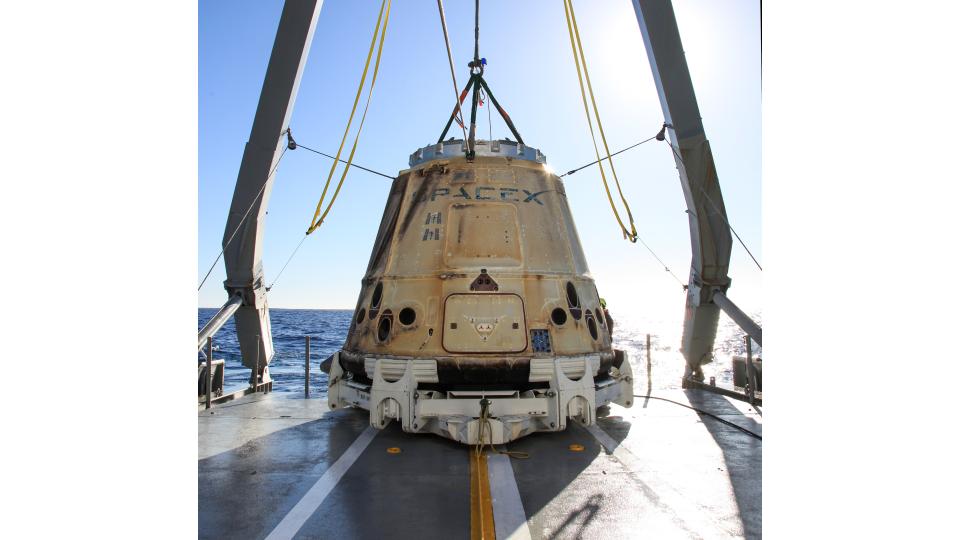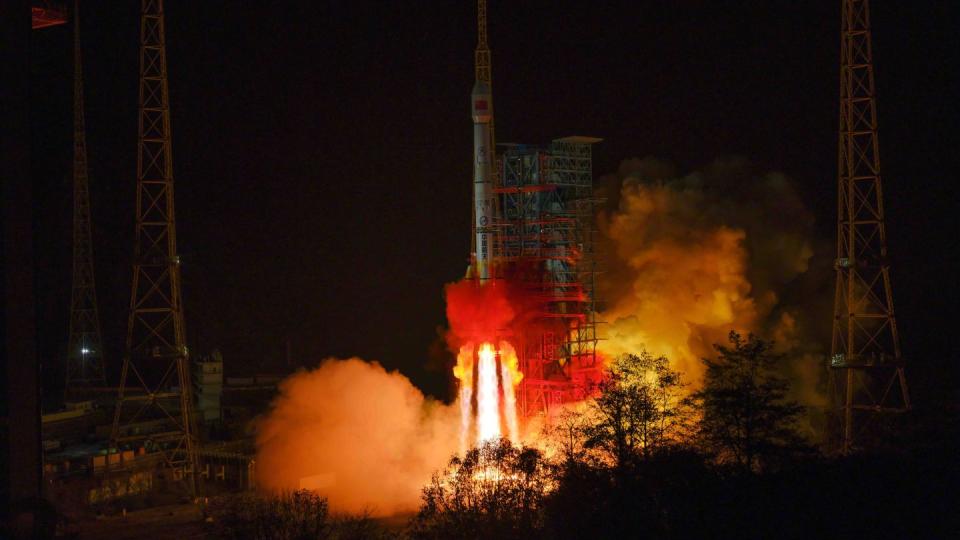It’s been a busy week! SpaceX counts like a computer, SpaceX now the largest satellite operator. One of the Starlinks isn’t like the others? China launches a super secret satellite. Mighty mice and space cookies return to Earth!

The first mission of the year was Starlink-2, where a SpaceX Falcon 9 rocket launched 60 additional satellites into orbit on January 7, 2020 at 2:19 AM (UTC).
Before we go on, we need to chat about the mission name. Yes, it was the third launch of Starlink satellites. And yes, the mission is really named Starlink-2. Why? There’s two ways to count: starting with one (what most people do), and starting with zero (what computers and therefore tech people do). SpaceX apparently decided to use the tech-centric naming convention for these launches, which leaves us with “Starlink” for the first launch, “Starlink-1” for the second launch, and “Starlink-2” for the third launch. Yeah, I know, it’s a little confusing. But it is what it is.
- Starlink-3 (RocketLaunch Live) https://www.rocketlaunch.live/launch/starlink-3
- Starlink Mission (SpaceX) https://www.spacex.com/news/2020/01/07/starlink-mission
- Starlink Mission January 2020 Press Kit (SpaceX, PDF) https://www.spacex.com/sites/spacex/files/starlink_media_kit_jan2020.pdf

With this deployment SpaceX becomes the operator of the world’s largest satellite fleet, with 180 satellites in orbit. Planet Labs, an Earth-imaging and test bed small-sat operator has launched more than 350 satellites into orbit to this point, but only 140 of those are still currently in orbit. Most of Planet Labs’ satellites have deorbited because they’re really small and just don’t have the room for additional tech to counteract drag from the atmosphere.
Additionally, this batch of satellites includes a single Starlink satellite that isn’t quite like the others. That one lone satellite has what SpaceX calls “an experimental darkening treatment” that’s designed to reduce its visible reflection to make it appear darker in the nighttime sky. The goal is to compare the visibility and performance of that satellite to the others in the constellation to assess the viability of using such a coating on future Starlink satellites.
There’s a catch with the darkening treatment. Because it won’t be reflecting as much light from the sun, it’s going to absorb that solar energy instead. Which means the components inside the satellite are going to be exposed to more heat. Too much heat could damage those components, rendering the satellite inoperative and making it another piece of space junk. Additionally, that heat is going to be expressed as infrared radiation because physics. If you damp out or remove one set of wavelengths emitted or reflected by an object, another set of wavelengths will pop up as a result. You might be wondering what the big deal with that is — the satellite is darker, it won’t interfere as much with observations, right? Wrong! As a reminder, there’s telescopes that perform observations and collect data in the infrared range, so it’s possible that the increased infrared radiation that results from this may still affect astronomers to a certain degree.
The hope is that the increased internal heating and infrared emission will be within operational limits for the payload while still providing a significantly reduced visible signature. As far as visibility goes, according to Pam Seitzer from the University of Michigan, we won’t know how the coating will affect visibility until the satellite reaches its 500 kilometer operational orbit at the end of February.
Around eight hours after a Falcon 9 was launched, CRS-19 came back to Earth after a month-long stay at the space station. According to a NASA press release, the SpaceX Dragon Cargo was released from the International Space Station at 10:05 AM UTC and splashed down nearly 40 minutes later in the Pacific Ocean off the coast of California. SpaceX reported a successful recovery of the craft.

Among the cargo returning to Earth are live mice and space cookies!
A DoubleTree representative that spoke with Space.com confirmed that all five cookies were baked and that space cookies were on board the returned craft. It’s unclear exactly how many cookies were baked, meaning that the ISS crew may not have had the chance to indulge in freshly-baked cookies. Before you panic, yes, they did get cookies — a tin of DoubleTree’s chocolate chip cookies were sent up along with the cookie dough.
Now, for the mice: yes, they came back alive! This is a bit unusual for animal experiments on the ISS — historically, animal subjects were often euthanized before being returned as biological specimens. The forty “mighty mice” will be allowed to recover from spaceflight and then studied to see if inhibiting myostatin is a possible method to prevent muscle and bone loss. Myostatin is the protein that literally tells your muscle cells to stop growing. When you inhibit myostatin, your muscle cells continue to grow. If this works, it could be used by both astronauts and people here on Earth to prevent or slow muscle and bone loss.
- Dragon Resupply Mission (CRS-19) Splashdown (SpaceX) https://www.spacex.com/news/2020/01/08/dragon-resupply-mission-crs-19-splashdown
- Dragon Released from Station Carrying Science for Earth-Analysis (NASA) https://blogs.nasa.gov/spacestation/2020/01/07/dragon-released-from-station-carrying-science-for-earth-analysis/
- Mighty Mice in Space: Preclinical Evaluation of a Broad Spectrum Myostatin Inhibitor to Prevent Muscle Loss and Bone Loss Due to Disuse (Rodent Research-19) (NASA) https://www.nasa.gov/mission_pages/station/research/experiments/explorer/Investigation.html?#id=8075
- The first cookies baked in space are back on Earth! (Space.com) https://www.space.com/first-space-cookies-zero-g-oven-on-earth.html
- Hilton DoubleTree Cookie Dough Launches With Zero G Oven for Space Station (Space.com) https://www.space.com/ng12-launch-doubletree-cookies.html

And to wrap up our very busy day in spaceflight, China launched a Long March 3B carrying the mysterious TJSW-5 mission at 3:13 PM (UTC).
- TJSW-5 (RocketLaunch Live) https://www.rocketlaunch.live/launch/lm3b-20200107

The TJSW 5 — or TJS 5 — is the fifth in a line of secretive satellites. China often announces the owner or end users of the satellites they launch, even if government-owned. This was not the case for this launch or for any of the others in the series. Chinese media outlet CCTV announced that the satellite “will be used in communication, radio, television and data transmission, as well as [a] high throughput technology test.”
However, observers have noted the similarity between this launch and that of TJS 2, launched on a Long March 3B back in January of 2017. Analysts have suspected that the TJS 2 satellite may have had a military mission such as missile launch and early warning detection, and that TJS 5 is likely to have a similar purpose.
- Image from People’s Daily (Weibo) https://www.weibo.com/2803301701/IoritAO6q?type=comment#_rnd1579030597975
And here’s a running tally of a few spaceflight statistics for the year:
As of 00:00 hours on January 15th, there are 61 new satellites in orbit from two launches. China and the USA have both launched a rocket.
- Toilets burned up: 0
- Total satellites: 61
- Total launches: 2
- China: 1
- USA: 1
And that rounds out our show for today.
Thank you all for listening. Today’s script was written by Annie Wilson and Dave Ballard. The Daily Space is produced by Susie Murph, and is a product of the Planetary Science Institute, a 501(c)3 non profit dedicated to exploring our Solar System and beyond. We are here thanks to the generous contributions of people like you. Want to become a supporter of the show? Check us out at Patreon.com/cosmoquestx


 We record most shows live, on Twitch. Follow us today to get alerts when we go live.
We record most shows live, on Twitch. Follow us today to get alerts when we go live.